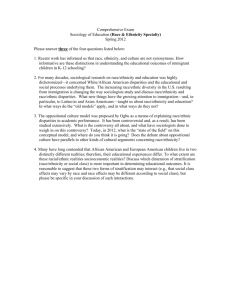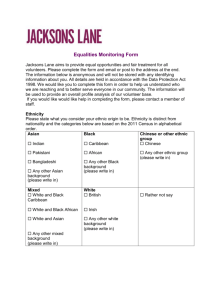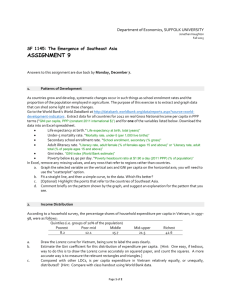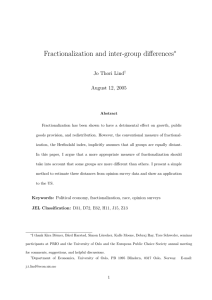Ethnicity and Political Accountability in Africa
advertisement
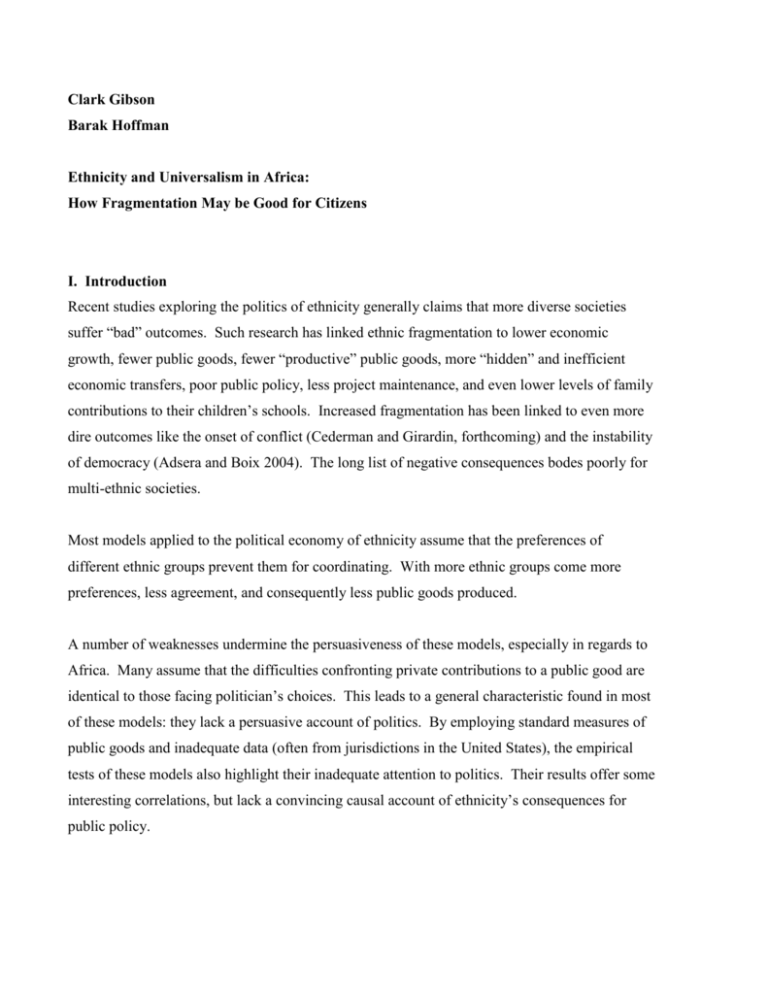
Clark Gibson Barak Hoffman Ethnicity and Universalism in Africa: How Fragmentation May be Good for Citizens I. Introduction Recent studies exploring the politics of ethnicity generally claims that more diverse societies suffer “bad” outcomes. Such research has linked ethnic fragmentation to lower economic growth, fewer public goods, fewer “productive” public goods, more “hidden” and inefficient economic transfers, poor public policy, less project maintenance, and even lower levels of family contributions to their children’s schools. Increased fragmentation has been linked to even more dire outcomes like the onset of conflict (Cederman and Girardin, forthcoming) and the instability of democracy (Adsera and Boix 2004). The long list of negative consequences bodes poorly for multi-ethnic societies. Most models applied to the political economy of ethnicity assume that the preferences of different ethnic groups prevent them for coordinating. With more ethnic groups come more preferences, less agreement, and consequently less public goods produced. A number of weaknesses undermine the persuasiveness of these models, especially in regards to Africa. Many assume that the difficulties confronting private contributions to a public good are identical to those facing politician’s choices. This leads to a general characteristic found in most of these models: they lack a persuasive account of politics. By employing standard measures of public goods and inadequate data (often from jurisdictions in the United States), the empirical tests of these models also highlight their inadequate attention to politics. Their results offer some interesting correlations, but lack a convincing causal account of ethnicity’s consequences for public policy. In this paper we present a model of the political economy of ethnicity by building Cox and Tutt’s (1984) model of legislative choice. This model addresses how legislators make budget choices under the conditions that are often found in Africa: weak parties, zero-sum budgetary rules, majority rule, and geographic representation. Under these political constraints, we hypothesize that politicians will indeed coordinate and choose a rule of universalism. The greater the ethnic fragmentation, the more likely logrolling will take place, which in turn leads to greater public expenditure. We test our model using sub national level data from Zambia, allowing us to control for the institutional variation that hounds other studies. We find strong evidence that universalism occurs in Zambian district councils; we interpret this as coordination and argue that the subsequent increased expenditure on citizens is a good, not bad, outcome. II. Ethnicity and public goods At the heart of studies about ethnicity’s effect on public goods is an arguments about coordination failure. An increasing number of ethnic groups is supposed to generate more negotiation costs, additional preferences about outcomes, and growing resentment about which groups should share the public goods. These problems, either individually or in some combination, can stymie the coordination necessary for these groups to reach greater levels of social welfare. We divide recent work regarding ethnicity and collective outcomes into two groups that, while theoretically distinct, are often conflated. The first argues that increased ethnic fragmentation challenges the production of collective goods in the absence of public authority. Fearon and Laitin (1996) explore the elements of cooperation between ethnic groups. Miguel and Gugerty (2005) find that household contributions to local schools are lower in ethnically heterogeneous East African villages. Khwaja (2002) finds project maintenance suffers in more socially fractionalized villages in Pakistan. HHPW (forthcoming) observe that more ethnically fragmented neighborhoods in Uganda have more difficulty providing for their own security than do homogenous neighborhoods. They also run a series of experimental games with Ugandan citizens that support this general under provision of public goods result. These studies represent classic approaches to collective goods provision. Individuals fail to provide contributions to a collective good because others can free ride (Olson 1965). Mechanisms outside the simple structure of a collective goods game are needed to reach some agreement, and thus the provision of the good. Many scholars view ethnicity as either the solution or a key impediment to coordination. Homogenous ethnic groups can furnish various mechanisms – altruism, social cues, norms of reciprocity, the possibility of increased sanctions1, similar preferences, etc. – that help solve this dilemma.2 Essentially, homogeneity decreases the probability of individual defection from the cooperative outcome. Studies have found that homogenous ethnic groups have created ingenious solutions to their collective action problems (Greif 1992, Wade 1994, Ostrom 1990, Biggs 1996, Macours 2003, Okten and Okwonko-Osili 2004). The flip side of this argument is that increasing ethnic heterogeneity places additional barriers to coordination. The collective good is even less likely to be provided with increases in ethnic groups.3 The theory and evidence from the private ethnicity/collective goods approach is linked to -- and sometimes motivates -- studies of ethnicity’s effects on public policy. A large body of work blames ethnic homogeneity for policy that under provides public goods (Easterly and Levine 1997, Collier and Gunning 1999, Alesina, Baqir, and Easterly 1999, Alesina, Baqir, and Easterly 2000, Alesina and LaFerrara 2000). Many of these same studies cluster private collective goods situations with public policy. Habyarimana et al.’s investigation of ethnicity and collective goods connects the failure the Ugandan community to provide its own security with examples of government policy that yield low levels of public goods. In their theory of the effects of ethnic heterogeneity, Alesina and La Ferrara state “Consider a community, say a country, with K different types of individuals…”. (p. 766). Miguel and Gugerty (20xx) link the complementary” literatures of social sanctions with low level of government-provided public goods to argue that the former is understudied as compared to the latter. Alesina, Baqir, and Easterly (1999) move seamlessly between these two ideas as they discuss the poor policy outcomes associated with increased ethnic heterogeneity. Collier (2000) makes the differences between the private and 1 Besley, Coate and Loury (1993), Besley and Coate (1995), Wydick (1999), and Fehr and Gachter (2000). Habayrana et al. (forthcoming) group these mechanisms into the categories of preferences, technologies, and strategies. 3 Many social divisions have been explored to examine their impact on collective action, such as income (xxxx) and religion (xxxx). The models are in many cases identical to the ones used to investigate ethnicity. 2 public provision of public goods a matter of “size and complexity of organization and generalization” rather than one of theory. But these coordination problems are significantly different in their incentive structures, solutions, and implications. In the private collective goods situation, individuals are trying to reach greater levels of social good. Their solution must prevent free riding. One of the central features of this dilemma is its lack of institutions. A solution must either lean on existing social institutions or create them de novo (Ostrom 1990). A government, on the other hand, is replete with institutions designed specifically to generate and distribute public goods. This is a fundamental part of what governments do. Their decisions are sometimes about free riding but also about how they can simultaneously meet their own needs and the preferences of the citizens that put them in office. Extant political institutions such as electoral and governmental rules produce the specific set of incentives that decision makers confront. These incentives may be quite different from those generated by a simple collective goods game. This is the realm of politics, and it is the focus of the rest of our paper. III. Politics, Ethnicity, and Public Good Provision Current models of ethnicity’s effect on public goods provision lack persuasive accounts of politics, both in their models and in the measures they employ to test them. Easterly and Levine’s (EL) foundational study was one of the first to see a link between public goods provision and ethnicity. EL do not offer a strong theory about the mechanism that links a national measure of ethnicity with levels of public good provision or economic growth. Instead they state: “Ethnic diversity may increase polarization and thereby impede agreement about the provision of public goods and create positive incentives for growth-reducing policies, such as financial repression and overvalued exchange rates, that create rents for the groups in power at the expense of society at large.” This could be true, but LV test this by running cross country growth regressions with ethnicity measures as one of the explanatory variable of interests, as well as correlate ethnicity measures with several types of “growth-promoting” pubic goods (these are not an exhaustive list, just the ones they chose). They find that any direct effect of ethnicity on growth depends on their measures of ethnicity. They also find that correlations of ethnicity measures with their “growth-promoting” public policies are significant – but not uniformly so.4 Despite their claim that they “examined the sensitivity of the finding that ethnic diversity hinders the adoption of growth-promoting public policies,” their study does not actually model or test the political institutions in any way. There are no voters or legislators, no legislative or electoral rules. This is especially alarming in a cross country test. Unlike EL, Alesina, Baqir, and Easterly (1999) inject a more clearly articulated model of politics in their study of include a more explicit model of political choice. ABE 2000 Collier 2000 Alesina and La Ferrera 2006 IV. Our Approach We seek to explain the effect of ethnicity on district councils’ expenditure in Zambia. We do so by borrowing models of universalism found in the American legislative politics literature. When there are geographic-specific benefits to distribute, widespread agreement that politicians often seek inclusive rather than exclusive policies, i.e. universalism. Early work has focused on its long term rationality (Weingast 1979; Fiorina 1981). Legislators consider the division of the pie over time. If they have a high probability of being in a majority or coalition that ensures a higher than 1/n slice, they will not opt for universalism. Their benefits are higher since they receive the same payoffs but their constituents pay less taxes since fewer projects will be authorized (Weingast 1979). When they are excluded from the winning coalition, then their district pays more taxes and gets fewer benefits, which is a worse outcome than that achievable with universalism. Weingast argues that if legislators wish reelection, distribute benefits to their “While every measure of ethnic diversity is not significantly related to every public policy indicator in every subsample of countries, each ethnic diversity measure is significantly related to various public policy indicators that are significantly correlated with economic growth in every subsample that we examined.” EL QJE 1997: 1232 4 constituents to do so, and assume all coalitions are equally possible, then they will opt for a norm of universalism. Our empirical case differs from Weingast’s study of the U.S. Congress in three important ways. First, district governments in Zambia have virtually no committee system, making more appropriate the use of abstract models of majority decision making. Second, unlike Congress, the decision made by district councilors are constrained by zero-sum budgeting: the council must raise the money it spends on these projects, and the central government allows districts to accumulate no debt. Third, political parties are weak. This is one of the significant criticisms of the Weingast model, but Zambian political parties are personality rather than platform based. Their existence, as well as any collations they might forge, is ephemeral. Given these conditions, a better model comes from the work of Cox and Tutt (1984). Consider the members of a legislature confronted with deciding how to distribute a fixed amount of resources. This is a classic divide the dollar game (Ordeshook 1973; Fiorina and Plott 1978). Suppose that the first meeting is to decide on a norm of future allocations. Assume that implementing the norm chosen is costless, but that changing the norm in the future would incur negotiation costs. Each legislator calculates how much he or she would receive on average with unconstrained majority rule. If the legislator expects an average of less 1/n, then the clear choice would be to vote for the 1/n norm. But the result still hold even if the legislator expects to receive no less than 1/n, since an unconstrained voting institution of majority rule is risky. The individual might end up with less than 1/n. Consequently, the legislators insure themselves for the times that they might end up on the short end of allocations. Cox and Tutt’s formal representation of this situation (Appendix 1) demonstrates that this result holds even when the individual may expect to be in majority coalitions fairly often. We adapt this model to account to our case of explaining how ethnicity might affect district council budget expenditures in Zambia. Our “n” is the measure of language fractionalization. Given that we are interested in the effects of ethnicity, our “n” is therefore not the total number of individuals, but the measure of ethnic fractionalization in the district. Since district councilors represent wards, a geographic unit, we assume that an increased number of languages in a district will be represented in the district council. Hypothesis: Unlike those who believe that language fragmentation might lead to a lack of coordination among legislators, we argue that such fragmentation leads to universalism. Greater fragmentation creates more uncertainty in politicians’ minds about whether they will be in the majority group or not, thus providing them with an incentive to follow a norm of universalism to gain at least an equal share. We should see the effects of universalism in public expenditure. To meet the needs of more groups, higher levels of ELF will generate higher levels of expenditure. Lower levels of ELF, on the other hand, are more likely to result in majority groups, or coalitions, and thus reduce expenditures. V. Data and Analysis In this section, we examine the effect of language fragmentation on local government expenditure in Zambia. Zambia is an excellent country to examine how the former affects the latter. First, local governments in Zambia exercise considerable autonomy, have equivalent power over taxation and expenditures, and hold equivalent responsibilities. Crucially, they have wide latitude in raising local taxes and are free to expend those sources of revenue without oversight from the central government. Second, there exists significant variation in the degree of fragmentation across districts. As a result, we can examine how fragmentation affects patterns of taxation and expenditure under the same set of political institutions. Our unit of analysis is the district and we use the term district government and local government interchangeably. There are seventy two districts in Zambia. We focus on this unit of government because it is the principal sub-national administrative, electoral, and political unit. Lower levels of sub-national administration, such as villages, hold highly restricted fiscal powers, and the higher level of subnational government, the province, is not an electoral unit. One issue that we want to make clear is that total local government expenditure in Zambia equals total local government taxation. Our dependent variable, (log per capita) local government expenditure, does not contain any central government transfers or foreign aid. Consequently, any results that we find about the effect of fragmentation on the level of local government expenditure, by definition, hold for the level of local government taxation as well. Before examining the data, the most important issue we must discuss is how we measure fragmentation in Zambia. We faced two dilemmas in undertaking this decision. First, do we measure ethnic or language fractionalization? Second, how do we enumerate the different groups? The data on fragmentation comes from the 2000 census which lists approximately thirty ethnic groups and about fifty languages. The census contains these data for each district. We chose to measure fractionalization employing language, rather than ethnicity, for empirical and theoretical reasons. The theoretical one comes from Posner (2005) who contends that since Zambia’s democratic transition in 1991, language has become a more salient social cleavage than ethnicity. Empirically, the census only contains ethnicity by district for seven of the nine provinces but has language by district for all nine.5 More problematic than determining whether to measure fragmentation by ethnic group versus language group was determining how to count the latter. We faced three options. First, we could calculate language fractionalization directly from the census data. Second, we could follow Posner (2004) and calculate this variable using only the politically relevant groups (PREG). Third, we could follow Fearon (2003) and combine languages according to their degree of similarity. This process aggregates into similar groups language dialects and languages that are closely related. We follow Fearon’s approach for two reasons. First, to calculate PREG requires that we have data for which linguistic groups are relevant at the district-level since this is our unit of analysis (Posner 2004: 854-855). Posner’s approach produces the most accurate measure of fractionalization for political purposes. Unfortunately, to identify the relevant groups at the 5 The census from Eastern and Northern Provinces do not list ethnicity by district, only for the province as a whole. The reports do not enumerate why the government does not report ethnicity data for these districts. district-level within Zambia requires extensive field research that we have not yet had the time to undertake although we anticipate undertaking this task in the near future. Second, Fearon’s approach permits us the ability to place dialects and local variants of the country’s most widely spoken languages that the census data report into a small number of groups. Fearon (2003) identifies five language groups in Zambia and we used Ethnologue to aggregate languages citizens report speaking in the census into each of the five main groups.6 The graph below plots language fragmentation using each language the census identifies as a separate group against Fearon’s aggregation.7 Although the correlation between the two is quite high, we can observe the difference between the two measures of language diversity through outliers, such as Samfya District. The main language in Samfya, according to census data is Bemba which approximately 36% of the population reports speaking as its primary language. The second and third most common languages, according to the census, are Kabende and Ng’umbo, which 21% and 27% report speaking, respectively. Consequently, the index of language fragmentation according to the census data is approximately 0.7. However, because both of the latter two languages are closed variants of Bemba, when we calculate the index employing Fearon’s method of aggregating close languages, the measure of fractionalization falls to about 0.1. 6 Fearon lists Bemba, Tonga/Ila/Lenje, Nyanja, Lunda/Kaonde, and Barotse (Lozi) as the five main language families in Zambia. We excluded any language people report speaking that was not one of these five groups. 7 We calculate language fractionalization using the standard measure of one minus the sum of each group’s squared representation share. Language Fragmentation in Zambia 1 All Languages 0.8 Samfya Chipata 0.6 Correlation = 0.69 0.4 0.2 0 0 0.2 0.4 0.6 0.8 1 Five Main Groups The histogram below shows the distribution of language groups at the district-level in Zambia. Approximately one-third of the seventy two districts in Zambia have a fractionalization value of less than 0.2 and about one-third have a value of greater than 0.35, with the balance in between these two values. Consequently, we have a significant amount of variation in linguistic fractionalization at the district-level in Zambia, including ten districts with a fractionalization value of 0.11 or less and ten with a value of 0.5 or greater. Distribution of Language Fragmention of Five Main Groups Across Zambia 0.30 0.30 0.25 0.25 0.20 0.20 0.15 0.15 0.10 0.10 0.05 0.05 0.00 0.00 0.10 0.20 0.30 0.40 0.50 0.60 0.70 To estimate the effect of language diversity on local government expenditure, we regress log per capita total government expenditure on language fractionalization as well as other important control variables. Before presenting the results, it is important for us to discuss our estimation strategy and data sources. Perhaps the most important concern with our model is serial correlation with government expenditures. Consequently, we cannot interpret our results to suggest that fragmentation will cause changes in expenditure over time. Rather, we are estimating a structural model and thus the effect of fractionalization on expenditure should affect primarily the level of expenditure, not annual changes. The estimation technique we employ is analogous to the one Alesina, et al. (1999) use to assess the effect of ethnic fractionalization on the provision of public services in the United States. Alesina et al. use structural variables, such as income per capita and population, in addition to ethnicity, to model the provision of various public services using a cross-section of data. Following a similar design, we examine the effect of language fragmentation on total log per capita district government expenditures in 2004. We also utilize three control variables, the district poverty rate, log population, and log area. We expect all three to reduce the level of per capita expenditures. As poverty rises, we conjecture that per capita taxes, and hence per capita expenditure, should fall. As the area of a district rises, the transactions costs for collecting taxes are likely to increase as well hence per capita expenditure should fall as area increases. And we expect per capita taxes to fall as population rises as a consequence of economies of scale inherent in much of government administration and the production of many local services. Data on these three variables comes from the 2000 census and 2000 Living Conditions Monitoring Survey. Data on government expenditure comes from district governments budgets we collected. Finally, because many language groups are concentrated in certain provinces, we include a province dummy variable as a check on our results. This variable can also partially control for variation in the quality of land. Since we have a cross-section, we are not able to employ district dummy variables however, we would also like to note that Alesina, et al. (1999) employ an analogous design, using state dummy variables with county and/or municipal governments as their unit of analysis. We present our results of the tests of these hypotheses in the table below. In columns one and two, we regress log per capita expenditure without provincial dummy variables on total fractionalization according to the raw census data and language group fractionalization aggregated into the five language groups, respectively. While each term is highly statistically significant in their respective model, the coefficient on our aggregated measure of fragmentation is more than fifty percent larger than the coefficient on the disaggregated measure. In column three we utilize both measures of fractionalization and find a rather startling result: while the correlation between the two measures of language fractionalization is 0.7, placed them in the same model the coefficient on total fragmentation loses statistical significance completely while the coefficient on our aggregate measure of fractionalization remains highly significant and virtually unchanged in magnitude. Column four shows that our results hold even after including provincial dummy variables. These results are especially impressive given that we have only about seven districts per province and the concentration of many ethnic groups within provinces. We also checked our results for the effect of outliers. Livingstone, a relatively wealthy district as Determinants of Log District Per Capita Expenditures in Zambia Lang Frac (All Groups) (1) (2) (3) (4) (5) (6) (7) Total Total Total Total Employees Administration Services 0.992 0.212 (3.20)*** (0.47) 1.503 1.424 1.088 0.797 0.308 0.635 (5.27)*** (3.10)*** (2.59)** (1.69)* (0.66) (0.65) -0.025 -0.022 -0.020 -0.021 -0.022 -0.016 -0.017 (3.00)*** (2.82)*** (2.77)*** (2.56)** (2.43)** (1.74)* (0.71) -0.297 -0.310 -0.315 -0.365 -0.512 -0.272 -0.588 (3.65)*** (4.05)*** (4.14)*** (4.29)*** (4.81)*** (2.27)** (2.84)*** -0.462 -0.436 -0.442 -0.432 -0.414 -0.423 -0.537 (5.53)*** (5.42)*** (5.39)*** (5.34)*** (4.86)*** (4.83)*** (2.42)** 11.241 10.914 10.863 12.219 13.252 8.791 14.741 (9.26)*** (10.22)*** (10.23)*** (9.09)*** (8.38)*** (4.91)*** (4.67)*** Province Dummy No No No Yes Yes Yes Yes Observations 57 57 56 57 60 56 59 0.70 0.73 0.74 0.79 0.72 0.67 0.47 Lang Frac (Five Families) Poverty Population (log) Area (log) Constant R-squared a result of being a popular tourist destination, has a very high level of heterogeneity and per capita expenditure. Our results do not substantively change by excluding this district nor do the results change if we exclude Lusaka (not shown). Finally, we would like to point out not only that our model suggests language fragmentation has a robust and statistically significant effect on per capita expenditure but that the model explains a substantial amount of total variation expenditures across districts as well. The last three columns in the table attempt to determine if fractionalization affects certain components of local budgets more than others. We separate the budgets into three categories: employee costs, administration, and public services. These are categories that the local governments define, not we, thus we cannot be certain that these measures are homogeneous across districts. The results of these tests are highly inconclusive and present only some weak evidence that greater fragmentation leads to larger expenditures on employees. However, the graphs below show that the raw correlations between fragmentation and sub-categories of expenditure across districts are low, especially after removing Livingstone from the sample. Unfortunately, as local governments do not follow uniform rules for sub-categories of expenditure, it is difficult for us to interpret the significance of these results. Fragmentation and Log Per Capita Recurrent Expenditures Log Per Capita Recurrent Expenditures 13 Correlation: 0.45 w/o Livingstone: 0.29 12 Livingstone 11 10 9 8 7 0 0.1 0.2 0.3 0.4 0.5 Fragmentation 0.6 0.7 0.8 0.9 Fragmentation and Log Per capita Expenditure on Services 9 Log Per Capita Service Expenditures Livingstone 8 7 6 Correlation: 0.35 w/o Livingstone: 0.23 5 4 0 0.1 0.2 0.3 0.4 0.5 0.6 0.7 0.8 0.9 Fragmentation The graph below shows that the effect of language fragmentation on per capita expenditure is not only statistically significant but economically significant as well using the results of model two in the table above. The graph shows that per capita expenditures in districts with a fragmentation value of 0.4, roughly the 75th percentile, are twice those in districts with a fragmentation level of 0.15, roughly the 25th percentile. However, we should also note that due to the small number of districts with fragmentation values less than 0.1 or greater than 0.5, the effect of language diversity on expenditures is more tentative in these regions. Effect of Language Fragmentation on Per Capita District Government Expenditures in Zambia (Thousands of Kwacha) 25 25 20 20 15 15 10 10 5 0.05 0.15 0.25 0.35 0.45 0.55 0.65 5 0.75 Language Fragmentation - Five Main Groups The table below demonstrates that the effect of language diversity on expenditure by comparing per capita expenditures from two districts that differ significantly in their degree of language diversity, Kafue and Mporokoso. The two districts are similar profiles in terms of their level of development and Kafue is much larger in terms of area and population than Mporokoso. All else equal, according to our model, per capita expenditure should be much lower in Kafue than Mporokoso. If these districts had the mean level of language fragmentation, for example, we would expect per capita expenditure in Kafue to be about 70% less than in Mporokoso. However, given that Kafue is far more diverse than Mporokoso, the model predicts that expenditure should be 80% higher in Kafue than Mporokoso. Thus, language diversity alone explains about half of the difference between per capita taxes in the two districts. Fractionalization and Taxes in Two Districts Kafue Mporokoso Poverty Rate 74% 76% Infant Mortality Rate 9% 9% Adult Literacy Rate 75% 70% Population 176,000 111,000 Area (Square KM) 11,000 6,590 Language Fractionalization 70% 11% Per Capita Taxes (Kwacha) 14,200 3,500 The graphs below attempt to show visually the effect of including language fractionalization in our model to explain variation in local government expenditure. The graph on the left shows the fitted values and the 95% confidence interval for model two in the table above without including our measure of language fractionalization; the graph on the right shows the same information for a model that includes this variable. The confidence interval from the model that includes fractionalization is substantially narrower, demonstrating the degree of accuracy we gain by including this variable. Effect of Langauge Fragmentation on Predicted Values 4 0 1 2 3 Log Per Capita Taxes 3 2 1 0 Log Per Capita Taxes 4 5 With Fragmentation 5 Without Fragmentation 1 2 3 Fitted values 4 5 1 2 3 Fitted values 4 5 Shaded Areas Represent 95% Confidence Interval In sum, our empirical results show that language fragmentation has an economically strong impact on per capita district expenditures at the local level in Zambia. The results hold after accounting for other economically important variables and after including fixed effects. Thus, we find that linguistic fractionalization has a strong logrolling effect. Unfortunately, the data are not clear as to whether increasing fractionalization has a stronger effect on the recurrent share of the budget or the service share. VI. Discussion Maybe ethnic frag not so bad. Arguably there is coordination. Arguably citizens are better off. (Not social efficiency.) Appendix 1 From Cox and Tutt (1984): for our model, n is language fractionalization. Let gi be the payoff to i, 0 ≤ gi ≤ 1; pi (gi) be i’s subjective probability of receiving the payoff gi, given that there is no norm; ui be i’s utility function; EVi be how much i expects to get on average, if the norm is not adopted [that is, EVi is the mean of the distribution pi(*)]; πi, be i’s risk premium; and ri, be the number of meetings i expects to attend. Proposition: Suppose that it costs nothing to vote on the norm. Then if πi > ri[EVi – 1/n] for at least ½ + 1 players i, the norm will be adopted. Proof: (without subscripts) each player expects a total gain under unconstrained majority rule of rEV, where EV = p(g)g dg. The risk premium π, is defined implicitly by the equation U(rEV – π) = r p(g)u)(g) dg. The norm will be supported if u(r/n ≥ r r/n > rEV – π ↔ π > i[EVi – 1/n]. p(g)u)(g) dg = u(EVi – 1/n), and thus if


